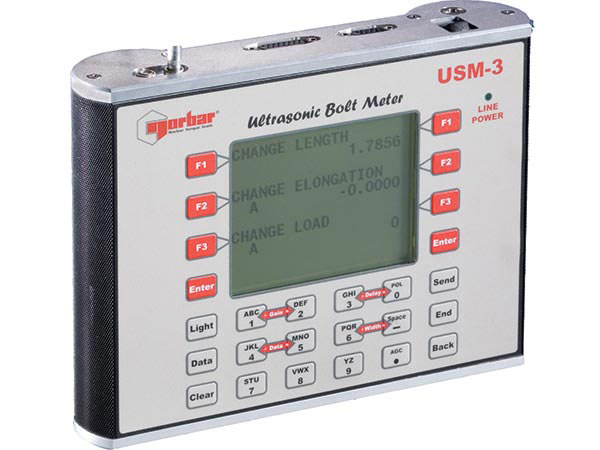
USM-3 Ultrasonic Stress Meter
As design engineers push the envelope to provide greater strength and efficiency in bolted joints, the use of torque, torque and angle, or even tensioning as the method of tension control may not be adequate, leading to costly failures. In those applications, ultrasonic bolt elongation/load measurement can provide accuracy equal to strain gauging without the need to strain gauge a bolt. In addition, the use of ultrasonic bolt measurement allows the user to return at any time and re-verify the level of tension in each fastener over its service life. The USM-3 has been both laboratory and field-proven to be the most accurate, reliable and cost-effective solution to bolting failures which could place workers at risk, lead to the loss of production and/or cause damage to capital equipment.
About the USM-3
The basic principle behind this method of tension control is similar to sonar. The ultrasonic measurement of bolt tension is achieved by introducing a sonic pulse at one end of the fastener and accurately measuring the time of flight (TOF) required for the echo to return from the opposite end. Using material constants, the USM-3 converts this TOF into an “acoustic length” of the fastener, providing a baseline from which future measurements will be made. When the fastener is tightened: the TOF increases and the USM-3 will again utilize material constants to eliminate the effects of stress and temperature variations on sound velocity, providing an accurate elongation or load measurement.
The USM-3 uses state of the art hardware and digital signal processing to achieve these measurements with maximum automation, minimizing the need for operator interpretation. Once measurements have been recorded to the USM-3 internal memory, the included Sonic Bolt software will transfer the data to a computer for backup of files, creation of project reports, and conversion of data to Excel format for further analysis. In addition, the analogue signal output can be used to automatically shut-off powered torque and tensioning tools based on elongation or load, in even the most demanding applications.
For more information visit www.norbar.com.
Features of the USM-3
- Large 1/4 VGA back lit display is easily visible from a distance and in poor light.
- Can store up to 4000 bolts, 20,000 elongation and load readings.
- Rugged steel and aluminum case designed for production, field and construction environments.
- USM-3 is supplied in a rugged watertight (Pelican®) case complete with AC adaptor, nylon carrying case, 10’ (approx. 3m) transducer cable, data transfer cable, 4 oz bottle of couplant, batteries and operator’s handbook.
- Measures fasteners of virtually any material from 1/2 inch (12mm) to over 50 feet (15m) in length.
- 0 - 10V analogue output for control of tightening tools such as a Norbar Pneutorque® multiplier.
Fast update speeds.
Measurement modes of pitch-catch and pulse-echo. - Unit can be operated with mains power supply (96 to 264 Volts) or via 4 ‘C’ cell batteries.
- Sealed membrane keypad with tactile keys.
- Works with magnetic and glue on transducers from 1 MHz to 10 MHz
Physical
Size: 9-7/16” (239mm)W x 7-1/16” (180mm)H x 2-1/16” (53mm)D
Weight: 4.95 lb (2.25 kg)
Keypad: Membrane switch with tactile keys.
Display: ¼ VGA backlit. 3-7/8”(98mm)W x 3”(76mm)H
Case: Sealed Aluminium.
Battery Power: 4 'C' Cells
Optional Line Power: 96-264 VAC 47 to 63 Hz.
Operating Temperature: 32°F to 110°F (0 to 43°C). Automatic Compensation for Temperature of Fastener.
Calibration: Automatic verification of system calibration Field verification of bolt material calibration constants.
Data Transfer: USB
Analog Output: 15 Pin 0 to 10 V Scalable
Ultrasonic
Resolution: 0.00001 inch (0.0001mm).
General: Pitch catch, pulse echo measurement modes. Automatic peak signal and phase selection.
Pulser: 160 volt push/pull tone burst. Selectable burst width. Selectable frequencies 1.0, 2.25, 5.0, 7.5 and 10 MHz
Receiver: Low noise preamplifier. Automatic gain control. Automatic waveform and signal diagnostic display.
Timing: 160 MHz 10 ppm TCXO controlled digitizer.
Memory: Non-volatile. Stores data on 4000 bolts, (5 elongations and 5 loads per bolt)
